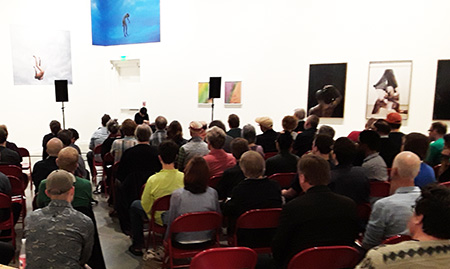by Daniel Hathaway

A sizeable audience gathered in the larger of the two galleries to hear a single as yet unnamed piece, embarking on the expedition without benefit of written or spoken program notes, except for a bio card that read:
As a composer and performer of electroacoustic music, Davachi is primarily concerned with disclosing the delicate psychoacoustics of intimate aural spaces, utilizing extended durations and simple harmonic structures that emphasize subtle variations in overtone complexity, temperament and intonation, and natural resonances… Similarly informed by minimalist tenets of the 1960s and 1970s, baroque leanings toward slow-moving chordal suspension, and experimental production practices of the studio environment, her sound manifests an experience that lessens apprehension of consonance and dissonance in likeness of the familiar and the distant.
If that resembles the opaque jargon that usually accompanies art installations, it proved to be an accurate description of the sound event that followed. Her piece began with pulsing, pizzicatos extended by halos of reverberation, then evolved at a glacial tempo, with slow, subtle changes of timbre and texture. Overtones appeared out of nowhere, making long crescendos as sounds became more complex and moved from low to middle register.
Textures thickened as the sonic metamorphoses continued, and timbres set up interference patterns, moving between dissonance and resolution. New layers appeared in the treble as pitch ranges trended upward.
Finally, melodic fragments from the pizzicatos that opened the piece reappeared, taking on more and more of a harmonic direction and a valedictory role. All that remained at the end were bass pitches that outlined cadential gestures, then faded into silence.

The instrumentation she employs is varied, including piano, electric organ, pipe organ, reed organ, tape-replay samplers, analog synthesizers, early western strings and keyboards, orchestral strings, brass, and woodwinds, with mutual idioms often layered in textural and timbral counterpoint.
Published on ClevelandClassical.com October 9, 2019.
Click here for a printable copy of this article



